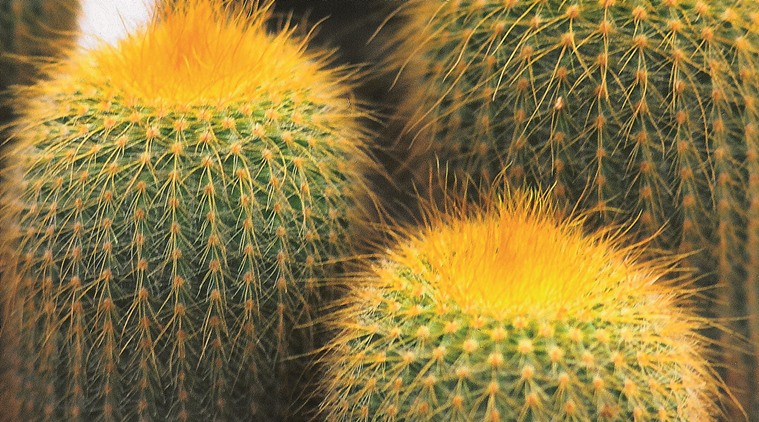Anyone who has ever been on a hike or trek or even out gardening has been a victim at some time or the other, a victim of allegedly non-violent, submissive plants that have caused sudden pain and drawn innocent blood! A careless step, reaching out to a tree branch for support, or more malevolently, a pair of saceteurs for that gorgeous velvety rose for your beloved, can all be dangerous to your health. You return home limping with a hole in your heel, or sucking your thumb, or alas, stabbed, not only in your hand but in your heart too. Thorns are a plant’s frontline defence system to ensure you don’t get too close or too cosy with them.

Botanists (like all scientists love doing) have classified these defence mechanisms into various categories. Technically, thorns develop from shoots, while spines develop from stems, buds or leaves. Both of these have vascular systems, which makes it difficult to remove them from the plant. Prickles, on the other hand, grow on the outside of stems, much like hair; they do not have vascular systems, and so, snap off easily. Roses, alas, have prickles, so, technically, the correct phrase is “every rose has its prickle” or “a rose between two prickles”, which sounds totally ridiculous and kills all the romance and heartbreak. A fourth category has simply been labelled, “other structures” and includes stinging hairs, fuzz or teeth (like some grasses have).
Story continues below this ad
Places which get low rainfall — scrub and thorn forests, and deserts — are known for their inhospitable spiky plants and trees, the cacti being, perhaps, the most celebrated of them. Because resources are scarce, it was believed that these plants evolved their spiky exterior to discourage predation, as repairing damage in such conditions are tough. In some cases, like cacti, where the thorny cover is very dense, it even provides shade to the leaves from the blistering heat. However, it has equally been argued, that plants growing in lush, tropical lands are also fiercely armed simply because they’re under greater pressure from herbivores that enjoy such leafy largesse.
Some birds, including owls and small songbirds, have taken advantage of this and excavated or built their nests deep in the thorny depths of such trees, even in cacti stems. I remember one such nest, built by a silverbill pair in Sultanpur right in the middle of a ferociously spiked acacia; I wondered how their babies would react when they emerged for their first flying lesson. “Oh god, trust mama and papa to build a home here: we’ll get skewered, if not shredded, if we try to get out.” “They don’t want us to leave home ever!” “They’ve grounded us forever.” A pair of bulbuls had, similarly, built a home in the depths of a thick, well-armed bougainvillea outside the drawing room — and which cats had tried in vain to get to. Even ants take advantage of thorns: the acacia ants of central America tunnel homes into the massive thorns of the bullhorn acacia in exchange for the sweet sap produced by the tree, and they come out fighting if a predator dares to take a bite; the herbivore will not only get a mouthful of thorns but also an attack of furious ants too.
What’s more insidious are plants that have covered their leaves with stinging hair, which, sometimes, consist of nasty hypodermic syringes filled with venom. The well-known bichchu-booti of the hills is one. It’s understood that these were further developed to keep herbivore insects at bay. The blades of many grasses are lined with teeth that resemble saws and can draw blood if you walk through them carelessly.
The gorgeous silk cotton or semul tree, when young, has the lower part of its trunk studded with sharp triangular prickles, which sounds misleading and ludicrous, because they look and feel more like the fearsome armour plating you’d encounter on dinosaur hide. It discourages animals from climbing up, while the tree is young and vulnerable, and god help any creature trying to slither down in a hurry — it would be like having your bottom scraped by a vegetable grater. The prickles are deadly sharp, although, as the tree matures, they get blunt and eventually drop.
Story continues below this ad
Thorns have been getting into our flesh since time immemorial. Even animals are not spared: there’s that old wonderful fable of the fugitive slave Androcles who pulled out a thorn from a lion’s paw, and was saved from being eaten in the Roman arena, by the same beast caught for the purpose, who recognised him.
But thorns, spines and prickles have their uses too — and have been used by villagers and householders the world over to protect their land and property from both beasts and humans. Even the cops recommend that you, perhaps, grow a row of spear-like agave or a thick hedge of bougainvillea or acacia around your property as an effective deterrent. It is; I once struggled for 20 minutes trapped in the depths of a thorny bush on the Delhi Ridge. And all I was doing was birding!
Ranjit Lal is an author, environmentalist and birdwatcher.
 Thorns, spines and prickles have their uses too — and have been used by villagers and householders the world over to protect their land and property from both beasts and humans. (Source: Ranjit Lal)
Thorns, spines and prickles have their uses too — and have been used by villagers and householders the world over to protect their land and property from both beasts and humans. (Source: Ranjit Lal)



























